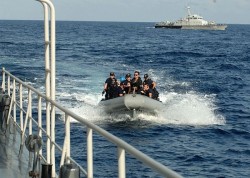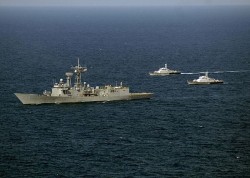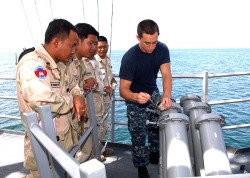
China and the United States are competing for influence throughout Southeast Asia and Cambodia appears to be the latest battleground. In January, China stepped up its defense cooperation with Cambodia in a development that several regional analysts saw as an attempt to supplant the United States. One writer, for example, likened China’s initiative to a “tug-of-war” with the United States.
The United States initiated defense cooperation with Cambodia in 2006 in response to Cambodia’s request for assistance. Over the next seven years the United States became Cambodia’s major—but not exclusive—defense-cooperation partner.
In 2007, the USS Gary (FFG-51) and the Essex (LHD-2) made separate goodwill port calls to Cambodia, and the U.S. Marines initiated a training program for Cambodia’s National Counter-Terrorism Task Force.
In 2008-09, the United States increased its financial support and enlarged the scope of its training programs. It provided $4 million to assist in building up demining capacity and initiated a new training program to increase the Cambodian armed forces’ capacity for participation in U.N. peacekeeping. The United States also provided funding for Cambodian officers to participate in multilateral exercises. Cambodia was the recipient of excess U.S. military equipment valued at $6.5 million.
A marked upturn in U.S.-Cambodia defense relations took place in 2009 when Cambodian Defense Minister Tea Banh paid an official visit to Washington to witness the opening of his country’s first defense attaché office. Tea Banh met with Defense Secretary Robert Gates, and they agreed to conduct a regular defense policy dialogue at senior official level.
During 2009 the two countries conducted their first joint rescue and salvage exercise by navy divers. The U.S. Marines joined with Cambodian personnel to conduct a medical- and dental-capabilities exercise. Cambodia joined the Global Peace Operations Initiative (GPOI), a largely U.S.-funded effort to train military forces for U.N. peacekeeping.
In 2010, during the visit of the USS Tortuga (LSD-46), Cambodia participated in the Cooperation Afloat Readiness And Training (CARAT) exercise for the first time. Cambodia and the United States co-hosted the major GPOI capstone exercise, Exercise Angkor Sentinel, involving 1,000 peacekeepers from 20 countries. Angkor Sentinel is now held annually as a bilateral U.S.-Cambodia exercise.
By 2011 the defense cooperation had evolved to include three major components: U.S. assistance in counterterrorism, training for peacekeeping, and professional military education. For example, a U.S. Special Forces augmentation team based at the U.S. Embassy conducts an annual joint counterterrorism exercise with a specialist Cambodian unit. U.S. Marines, embarked on the USS Pearl Harbor (LSD-52) and New Orleans (LPD-18), conducted training exercises with the Cambodian forces during a port visit. According to unofficial estimates, U.S. spending on defense cooperation tripled to $18.2 million.

China’s defense cooperation with Cambodia has evolved more slowly and has been opportunist. In 1997, for example, Cambodia experienced a violent domestic upheaval that led the United States and other members of the international community to impose sanctions. China, on the other hand, offered the Cambodian government a $10 million loan. Cambodia drew out $2.8 million to purchase Chinese military vehicles and requested Chinese assistance in military training.
In 2003, China and Cambodia signed their first memorandum of understanding on defense cooperation. Under the terms of that agreement China upgraded a military airfield and built barracks and officers’ quarters.
In late 2009, Cambodia forcibly repatriated Uighur asylum-seekers back to China over U.S. protests. When the United States canceled the delivery of military trucks in response, China stepped in and provided 257 military vehicles and 50,000 uniforms. The following year China provided a loan of $195 million to finance the purchase of 12 Zhi-9 helicopters and training for 25 pilots and mechanics.
In May 2012, the Chinese and Cambodian defense ministers signed a defense cooperation agreement valued at $17 million. Under its terms China agreed to train Cambodian military personnel in China and construct a training facility in Cambodia. In January the following year, Cambodia and China signed another defense agreement covering the provision of military equipment, materials and additional training. In particular, China pledged to provide military instructors and Chinese-language teachers at the Combined Arms Officer School in Kampong Speu province.
Assessing the Cooperation

Since 2009, China has been anxious about the determined efforts of President Barack Obama’s administration to recoup U.S. influence in and play a greater role in Southeast Asia. Chinese anxieties were raised in 2012 when the Obama administration began rebalancing the U.S. military presence in Southeast Asia, including Cambodia.
China is especially sensitive to any U.S. military presence in its back yard. Cambodia is, after all, a semi-authoritarian state where the military plays an important role in domestic politics and internal security. The United States, for example, has cultivated Prime Minister Hun Sen’s three sons, who all hold positions in the military.
The recent step up in defense relations between China and Cambodia indicates that Beijing seeks its own independent avenues of access of power. Chinese military assistance has three advantages over that of the United States. First, China can sell arms by offering soft loans. Second, China can fund military infrastructure projects. And third, China can provide military aid without attaching human-rights restrictions. Chinese aid is not completely disinterested; it comes with invisible strings, the expectation that Cambodia will take Chinese interests into account.
U.S. military assistance has its own advantages. The United States is quite good at providing aid that develops human and technical capacity. The United States can offer Cambodia a wide array of professional military education and training services. That ranges from full-time attendance at a staff college or military university, to a variety of short courses, such as logistics management, humanitarian assistance, civil military assistance, and military medicine. Plus, those training packages can be delivered in-country, tailored to the specific needs of Cambodia. The one U.S. disadvantage compared with China is that military assistance comes with human rights and other legislative strings attached.
Net Assessment
China has certain strengths in the kind of military assistance it can deliver. The recent increase in Chinese defense cooperation with Cambodia is aimed at redressing a deficiency in military-to-military relations with Cambodia and to counter U.S. influence. China is not attempting to outbid the United States and drive it from the military assistance marketplace.
The United States has different strengths in providing defense assistance that China cannot match, and cannot be pushed out of Cambodia that easily.
Cambodia gains by having two (or more) suitors. It is in Cambodia’s interest—or rather the interests of its political and military elite—to obtain military aid from both China and the United States. So Cambodia will continue to seek assistance from both—knowing that neither can afford to walk away and leave the field to the other.




